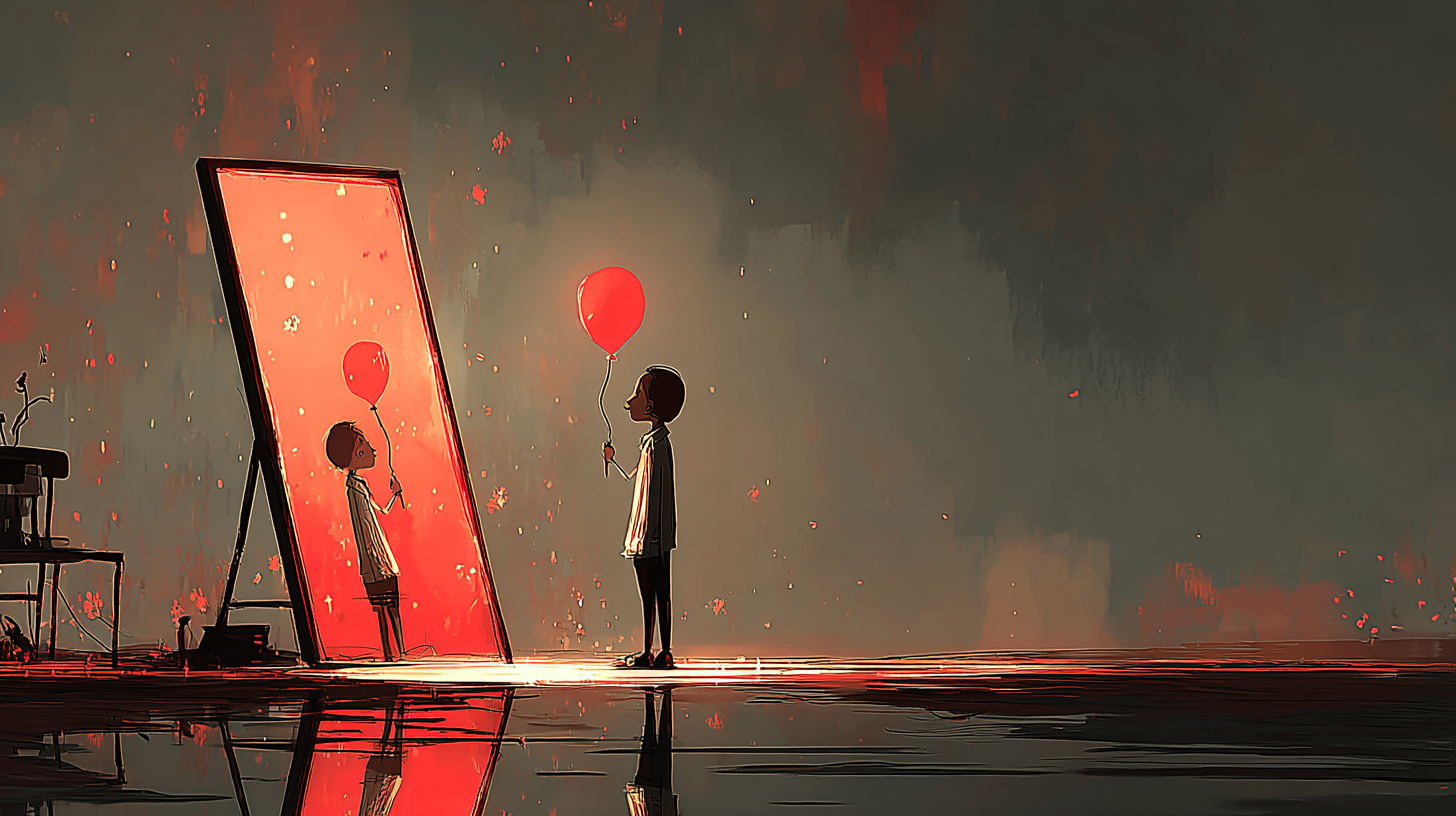“Image” means a picture or an idea in your mind.
「image」は「絵や写真などの見えるもの」や「心に浮かぶ姿・印象」を表す言葉です。
以下は英単語 “image” に関するストーリー型学習コンテンツです。まずは大枠の意味を理解して最後の文章で確認しましょう。
主な意味(main meaning)
| 品詞 | 意味 | 発音記号 | 例文 |
|---|---|---|---|
| 名詞 | 画像、映像、イメージ | /ˈɪmɪdʒ/ | The image on the screen was very clear. |
| 名詞 | 印象、心に浮かぶ姿 | /ˈɪmɪdʒ/ | She has a positive image in the company. |
| 動詞 | ~を心に描く、想像する | /ˈɪmɪdʒ/ | He could image a better future for himself. |
語源(etymology)
ラテン語 imago(像、姿)から来ており、「見える形」「頭に浮かぶ姿」が核のイメージです。
類義語(synonyms)
| 類義語 | 意味 | 例文 |
|---|---|---|
| picture | 絵、写真 | She showed me a picture of her dog. |
| photo | 写真 | I took a photo of the mountain. |
| figure | 姿、形 | A dark figure appeared in the distance. |
| vision | 心に浮かぶ像、視覚 | He had a vision of a bright future. |
反義語(antonyms)
| 反義語 | 意味 | 例文 |
|---|---|---|
| reality | 現実 | The reality was different from the image in my head. |
| fact | 事実 | The fact does not match the image people have. |
コロケーション(collocations)
| コロケーション | 例文 |
|---|---|
| public image | The actor cares about his public image. |
| mental image | I have a mental image of my hometown. |
| positive image | The company wants a positive image. |
| digital image | I saved a digital image on my computer. |
2項表現(binomials)
| 表現 | 例文 |
|---|---|
| black and white image | I saw a black and white image in the old book. |
| body and image | She cares about both her body and image. |
英語ストーリー(english story)
Tom was a young employee at a small design company. He often worried about his public image, because his boss cared about how the company was seen by clients. Tom wanted to create a positive image for both himself and the company, but sometimes he was nervous and made mistakes in meetings.
One day, Tom was asked to prepare a presentation for an important client. He had to show many digital images that the team had made for a new advertisement. Tom spent long hours checking each picture and photo, making sure that the colors were correct and the designs looked professional. He also thought about the company’s figure in the market, imagining how people would react to their work.
At night, when Tom was alone, he closed his eyes and tried to create a mental image of the presentation. He wanted to give the client a clear vision of the company’s strengths. However, the next morning, reality hit him. The projector in the meeting room was broken, and he could only show a few printed pages instead of the beautiful digital slides.
At first, Tom panicked. The fact was simple: he did not have the tools he had prepared. But then he remembered that an image was not only something people could see—it was also the impression they received. He decided to explain the ideas with confidence and energy.
During the presentation, Tom used some printed black and white images, but he spoke clearly about the colors, the design, and the meaning behind them. He showed how the company cared about both body and image, both the real product and the way it appeared to the world. The client listened carefully.
After the meeting, the client smiled and said, “I can image how this advertisement will look when it is finished. You gave me a strong mental picture.” Tom was surprised and relieved. He realized that sometimes the reality is not perfect, but a good explanation and a confident attitude can create a powerful image in people’s minds.
From that day, Tom stopped worrying too much about his public image. He understood that the most important thing was not only the photos or digital designs, but the way he connected with people and the trust he could build. He continued to improve his skills, always remembering that an image is more than just a picture—it is the story you give to others.
和訳
トムは小さなデザイン会社の若い社員でした。彼はよく自分の**public image(世間での印象)を気にしていました。なぜなら、上司が会社が顧客からどう見られているかを重視していたからです。トムは自分と会社の両方にpositive image(良いイメージ)**を作りたいと思っていましたが、ときどき緊張して会議で失敗することもありました。
ある日、トムは大切な顧客のためにプレゼンを準備するよう頼まれました。新しい広告のためにチームが作成した多くの**digital images(デジタル画像)を見せなければなりませんでした。トムは何時間もかけてそれぞれのpicture(絵)やphoto(写真)を確認し、色が正しく、デザインがプロらしく見えることを確認しました。彼はまた会社の市場でのfigure(姿・形)**について考え、人々が自分たちの仕事にどう反応するかを想像しました。
夜、一人になったトムは目を閉じてプレゼンの**mental image(心に浮かぶ姿)を作ろうとしました。顧客に会社の強みの明確なvision(将来像)**を見せたいと思ったのです。ところが翌朝、現実(reality)が彼を襲いました。会議室のプロジェクターが壊れており、美しいデジタルスライドではなく、印刷した数枚の紙しか見せられなかったのです。
最初、トムはパニックになりました。**fact(事実)**は簡単でした。準備したものを使えなかったのです。しかし彼は思い出しました。「imageとは、人が目で見るものだけではなく、受け取る印象そのものだ」と。そこで彼は自信とエネルギーを持ってアイデアを説明することに決めました。
プレゼンの中で、トムはいくつかのblack and white images(白黒画像)を使いましたが、色やデザイン、そこに込めた意味をはっきり説明しました。彼は会社がbody and image(実物とイメージの両方)、つまり現実の製品と世界にどう映るかの両方を大切にしていることを示しました。顧客は注意深く耳を傾けました。
会議の後、顧客は微笑んで言いました。「完成したときの広告が**image(想像)**できます。あなたのおかげで強い心のイメージができました。」トムは驚き、ほっとしました。彼は気づきました。現実(reality)は完璧でないこともある。しかし良い説明と自信ある態度は、人々の心に強いイメージを作れるのだと。
その日からトムは自分のpublic imageを過度に心配するのをやめました。最も大切なのは写真やデジタルデザインだけではなく、人々とどうつながり、信頼を築けるかだと理解したのです。彼はスキルを磨き続けました。そしていつもこう思い出しました。「imageとはただの絵ではなく、人に伝える物語そのものだ」と。
Q&A
Q: 「image」と「picture」の違いは?
A: 「picture」は実際に描かれた絵や写真を指します。一方「image」は写真や絵も含みますが、頭の中のイメージ(心に浮かぶ姿)や人からの印象も表せます。
Q: 「image」と「photo」の違いは?
A: 「photo」は「写真」の意味に限定されます。「image」は写真以外にも絵やCG、さらに心の中の想像や印象にも使えます。
Q: 「image」と「figure」の違いは?
A: 「figure」は「姿」「形」「人影」など、見える人や形に使います。「image」は写真や印象など幅広く使えるのに対し、「figure」は「形」や「人影」にフォーカスしています。
Q: 「image」と「vision」の違いは?
A: 「vision」は「未来像」「理想の姿」など、先のことを思い描く時に使われます。「image」はより一般的で、「心に浮かぶ姿」や「見える映像」を指します。
Q: 「public image」と「image」の違いは?
A: 「public image」は「世間や他人がその人・会社をどう見ているか」という外部からの印象を指します。単に「image」という場合は、もっと広く「心の中の姿」や「映像」も含みます。
Q: 「mental image」と「image」の違いは?
A: 「mental image」は「頭の中で思い浮かべるイメージ」で、目に見えない心の中の映像です。「image」単体は、写真や絵など実際に見えるものも含みます。
Q: 「positive image」と「image」の違いは?
A: 「positive image」は「良い印象」を特に強調する言い方です。「image」単体だと中立で、良い印象・悪い印象どちらも含みます。
Q: 「digital image」と「image」の違いは?
A: 「digital image」はパソコンやスマホなどで作られたり保存された「デジタル形式の画像」です。「image」単体だとデジタルに限らず、絵や写真、印象も含みます。



コメント